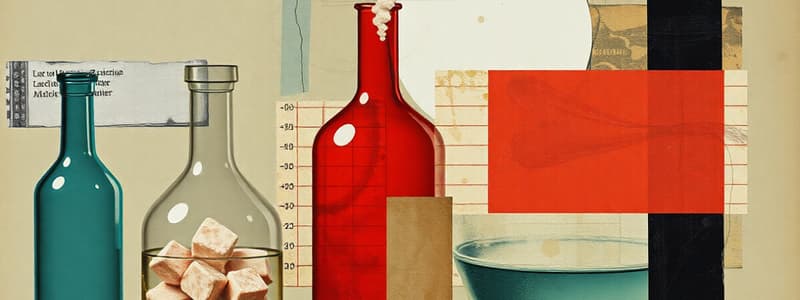Podcast
Questions and Answers
What is the primary purpose of using the condenser in the distillation process?
What is the primary purpose of using the condenser in the distillation process?
- To heat the saltwater more efficiently
- To increase the boiling temperature of the liquid
- To cool the steam and convert it back to liquid (correct)
- To remove impurities before condensation
Which statement correctly describes the order of processes in distillation?
Which statement correctly describes the order of processes in distillation?
- Boiling, cooling, condensing, and evaporating
- Boiling, evaporating, condensing, and cooling (correct)
- Condensing, boiling, evaporating, and cooling
- Evaporating, condensing, cooling, and boiling
In fractional distillation, what is the importance of different boiling points?
In fractional distillation, what is the importance of different boiling points?
- They indicate the physical properties of liquid mixtures
- They determine the order of evaporation and separation (correct)
- They allow all components to evaporate at the same time
- They are irrelevant to the distillation process
What is collected as the final product in the distillation process of seawater?
What is collected as the final product in the distillation process of seawater?
Which equipment is primarily used for boiling the saltwater in distillation?
Which equipment is primarily used for boiling the saltwater in distillation?
Which liquid in the mixture of ethanol and water has the lower boiling point?
Which liquid in the mixture of ethanol and water has the lower boiling point?
What happens to the impurities in saltwater during the distillation process?
What happens to the impurities in saltwater during the distillation process?
What method is used to increase the alcohol content in spirits like vodka and rum?
What method is used to increase the alcohol content in spirits like vodka and rum?
What is the main purpose of distillation in separating saltwater?
What is the main purpose of distillation in separating saltwater?
Which process is more suitable for collecting salt from saltwater rather than water?
Which process is more suitable for collecting salt from saltwater rather than water?
What happens to the salt when saltwater is subjected to distillation?
What happens to the salt when saltwater is subjected to distillation?
How does distillation separate water from saltwater?
How does distillation separate water from saltwater?
When using evaporation to obtain table salt, what source of energy is commonly utilized?
When using evaporation to obtain table salt, what source of energy is commonly utilized?
What is a common alternative method to directly separate salt from saltwater besides distillation?
What is a common alternative method to directly separate salt from saltwater besides distillation?
What is the role of cooling in the distillation process?
What is the role of cooling in the distillation process?
Which materials can be used to grow crystals at home?
Which materials can be used to grow crystals at home?
Flashcards are hidden until you start studying
Study Notes
Crystallisation
- Crystallisation is a process of separating a solute from a solvent.
- The solute is left behind as crystals when the solvent evaporates.
- Table salt is produced by crystallisation, using the sun to evaporate water from salt lakes.
- Copper sulphate crystals can be obtained by slow evaporation of a solution.
Distillation
- Distillation is a method for separating the solvent from a solution.
- It works because the solvent has a lower boiling point than the solute.
- When heated, the solvent evaporates, is cooled, and condensed back into liquid.
- The solute does not evaporate and remains behind.
Simple Distillation
- Simple distillation is used to separate the solvent from a solution when the solute has a much higher boiling point.
- The solvent vapour leaves the solution, is cooled, and condensed.
Distillation Apparatus
- A boiling flask (distillation flask) contains the solution.
- The solution is heated to the boiling point of the solvent.
- The solvent evaporates and becomes steam.
- The steam travels along a water condenser.
- The condenser is cooled by cold water.
- The steam condenses back into liquid water.
- The pure water is collected in a conical flask.
- The impurities and solute are left behind in the boiling flask.
Fractional Distillation
- Fractional distillation separates a liquid from a mixture of two or more liquids with different boiling points.
- When heated, the liquid with the lower boiling point evaporates first.
- For example, ethanol can be separated from a mixture of ethanol and water by fractional distillation.
- Pure ethanol boils at 78°C, while pure water boils at 100°C.
Distillation and Alcohol
- Distillation is used to make spirits (high alcohol content drinks).
- Ethanol vaporizes first, leaving the water behind.
- The pure ethanol can be further modified to make spirits.
Spirits vs. Wine and Beer
- Spirits, like vodka, rum, and whiskey, are made using distillation.
- Wine and beer are not distilled.
Studying That Suits You
Use AI to generate personalized quizzes and flashcards to suit your learning preferences.




